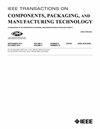100 Gb/s Multichannel TOSA With Low Tracking Error at the Industry Operating Temperature
IF 3
3区 工程技术
Q2 ENGINEERING, ELECTRICAL & ELECTRONIC
IEEE Transactions on Components, Packaging and Manufacturing Technology
Pub Date : 2025-06-05
DOI:10.1109/TCPMT.2025.3576864
引用次数: 0
Abstract
Tracking error is a crucial metric for assessing optical alignment changes in transmitter optical subassemblies (TOSAs) under varying temperatures. We present a 100 Gb/s four-channel TOSA developed for industrial temperature ranges (–100gb /s多通道TOSA,在工业工作温度下具有低跟踪误差
跟踪误差是评估发射机光学组件(tosa)在不同温度下光学对准变化的关键指标。我们提出了一种100gb /s的四通道TOSA,用于工业温度范围(- $40~^{\circ}$ C - $+ 85~^{\circ}$ C),具有增强的z套筒厚度(0.45 mm)和优化的光学对准。有限元分析(FEA)表明,在相同剪切载荷下,通过将z轴套厚度从0.35 mm增加到0.45 mm,最大应力从150 MPa降低到94 MPa,位移从5.5 ~ 3.6 mu $ m降低。同时,均方根(rms)位移范围在55.8 ~ 7.6~\mu $ m之间,实现了光束准同轴对准。此外,热特性分析表明,优化后的0.45 mm结构在所有通道和温度下都能将跟踪误差保持在0.4 dB以下。这些结果证实,机械增强和精确光路对齐的双重策略有效地提高了热稳定性,满足数据中心和5G/6G应用的高密度波分复用(WDM)系统的严格要求。
本文章由计算机程序翻译,如有差异,请以英文原文为准。
求助全文
约1分钟内获得全文
求助全文
来源期刊

IEEE Transactions on Components, Packaging and Manufacturing Technology
ENGINEERING, MANUFACTURING-ENGINEERING, ELECTRICAL & ELECTRONIC
CiteScore
4.70
自引率
13.60%
发文量
203
审稿时长
3 months
期刊介绍:
IEEE Transactions on Components, Packaging, and Manufacturing Technology publishes research and application articles on modeling, design, building blocks, technical infrastructure, and analysis underpinning electronic, photonic and MEMS packaging, in addition to new developments in passive components, electrical contacts and connectors, thermal management, and device reliability; as well as the manufacture of electronics parts and assemblies, with broad coverage of design, factory modeling, assembly methods, quality, product robustness, and design-for-environment.
 求助内容:
求助内容: 应助结果提醒方式:
应助结果提醒方式:


